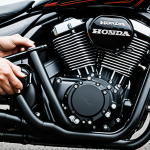Understanding Suspension Basics
In the realm of suspension basics, a solid grasp of fundamental components can significantly enhance the performance of a motorcycle like the Ducati Hypermotard 939. The primary elements include springs, dampers, forks, and shock absorbers, which work in harmony to provide stability and comfort.
The role of each component is vital; springs support the weight and absorb impacts from the road, while dampers control the motion of the springs, affecting how quickly they rebound after compression. Forks and shock absorbers aid in maintaining tire contact with the road, ensuring efficient handling.
In the same genre : Master Your Honda Fury Maintenance: Top DIY Hacks for Oil and Filter Changes
Calibrating your suspension correctly is crucial for achieving an optimal blend of ride quality and handling precision. Misaligned or improperly set suspensions can adversely affect the motorcycle’s performance, leading to diminished handling and comfort. Without proper calibration, issues such as excessive front dive under braking or rear squat during acceleration can occur.
Ultimately, the objective of fine-tuning your suspension is to tailor it to your riding style and preferences. This ensures that you not only harness the full potential of your Ducati Hypermotard 939 but also enjoy a safer and more enjoyable ride.
This might interest you : Mastering Your Suzuki GSX-R1000: The Ultimate Guide to Essential ABS Adjustment Settings Revealed
Tools and Equipment Needed for Calibration
Understanding the tools and equipment required for suspension calibration is crucial for optimizing your motorcycle’s performance. Essential tools include torque wrenches, suspension pump, and calipers. These instruments allow for precise adjustments and accurate measurements, essential for effective tuning.
For torque measurements, a high-quality torque wrench is indispensable. It ensures bolts are tightened to the correct specification, preventing damage to components. A suspension pump is needed to fine-tune air suspension settings, allowing you to adjust based on rider weight and preferences.
Calipers are vital for measuring sag and ride height accurately. They provide exact readings, which are essential for setting suspension geometry to suit your riding style. For those seeking cost-effective options, basic adjustable wrenches and a standard tape measure can provide a functional, albeit less precise, alternative.
Investing in these calibration tools ensures your Ducati Hypermotard 939’s suspension is set up for optimal performance. These tools help in achieving comfortable, stable rides while maintaining tire contact, improving handling and safety. Regular use can also extend the suspension system’s lifespan, further enhancing value.
Step-by-Step Suspension Calibration Guide
The suspension calibration steps are crucial for fine-tuning your motorcycle to match your riding preferences and ensure optimal performance. The tuning process can be intricate, but following a structured setup guide can simplify it significantly.
Pre-calibration Checks
Before commencing, ensure your bike is stable on a level surface to facilitate precise adjustments. Measure your current suspension settings, including sag and ride height, using measurement tools, such as calipers. This baseline helps identify necessary changes tailored to both rider weight and riding styles.
Adjusting Rebound and Compression
Rebound and compression adjustments are pivotal in the suspension tuning process. Rebound handles how fast the suspension extends after being compressed, while compression deals with the rate at which it compresses. Begin by setting these aspects to the factory recommendations and make incremental adjustments based on the road conditions and your personal comfort.
Setting Sag and Ride Height
Sag and ride height settings are pertinent to ensuring proper contact between tires and road surfaces. Using calipers, measure sag with the rider seated on the bike wearing full gear. Adjust the preload to fall within recommended sag values, tailoring it further according to your preferred riding conditions. Proper setup maximises handling, stability, and comfort, enhancing your overall riding experience.
Common Mistakes to Avoid During Calibration
In the world of suspension tuning, even small errors can have significant impacts on your Ducati Hypermotard 939’s performance. By identifying and avoiding these mistakes, you can ensure a smooth, stable, and comfortable ride.
One frequent mishap is overlooking sag measurements. Sag is critical for maintaining proper tire contact with the road, affecting both handling and comfort. Precise measurement and adjustment of sag with the rider in full gear are essential. Without accurate sag settings, you may experience issues like instability during cornering or uneven tire wear.
Another common calibration error is disregarding rider preferences and styles. Each rider has unique needs, influenced by their weight, riding style, and terrain. Failure to consider these factors when adjusting suspension settings can lead to a less than ideal riding experience.
Finally, not thoroughly testing settings after making adjustments can compromise the benefits of your calibration efforts. Best practices include taking the bike for test rides under various conditions to ensure that the adjustments meet your expectations. This iterative approach allows fine-tuning for improved performance and comfort.
Avoiding these pitfalls enhances your suspension tuning efficacy, yielding a better ride tailored to your needs.
User Experiences and Comparisons
Understanding how other riders adapt suspension settings can offer valuable insights. For Ducati Hypermotard 939 enthusiasts, feedback reveals a distinct preference for tailored suspension over stock settings. Many riders remark that customized suspension significantly enhances their ride experience, allowing for superior handling and comfort on variable terrains.
Real User Experiences with Suspension Calibration
Riders of the Ducati Hypermotard often share anecdotal evidence highlighting the transformative effects of proper suspension calibration. They report better maneuverability and less fatigue during long rides. Smooth transitions and improved grip on diverse road conditions are frequently noted as key benefits of personalized setups.
Stock vs. Customized Settings
Comparisons between stock settings and customized adjustments show a clear trend towards personalization. Stock settings are generally a one-size-fits-all solution, while custom settings cater specifically to individual riding styles and conditions. Adjustments that accommodate rider weight and preference improve both stability and responsiveness.
Impact of Calibration on Ride Quality
The direct impact of careful suspension calibration on ride quality cannot be overstated. Tailored settings are known to enhance ride quality, reducing oscillations and instabilities even in challenging environments. Ongoing tweaks, based on frequent rider feedback, ensure that the adjustments remain in harmony with changing circumstances, providing a smoother, more enjoyable ride.
Maintenance Tips for Suspension Systems
Regular upkeep is key for maintaining the suspension performance of your Ducati Hypermotard 939. Routine checks ensure prolonged system longevity and optimal functionality. Begin by inspecting suspension components frequently. Look for signs of wear, like oil leaks from forks or shock absorbers, which indicate it’s time for attention.
Cleaning and lubrication are crucial. Dust and debris can affect performance, so clean the suspension areas regularly. Use appropriate lubricants to keep joints and seals in good condition, preventing premature wear and maintaining a smooth operation.
Be vigilant about recognising maintenance indicators. If you notice excessive vibration or a rough ride, it may signal the need for recalibration or replacing parts like the springs or dampers. Unusual noises could also suggest issues that require professional assessment.
For peak performance, adhere to a structured maintenance schedule. This includes checking suspension bolts for tightness, ensuring they meet manufacturer torque specifications. Ignoring these can lead to handling problems.
In summary, regular maintenance helps keep your suspension system efficient and safe. This proactive approach not only extends the lifecycle of suspension components but also enhances your riding experience.





